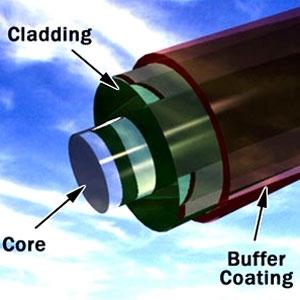- Related articles
- Optical Transceivers for Cisco WS-C2960S-F48FPS-L Switch
- Optical Transceivers for Cisco SF302-08PP-K9-EU Switch
- Applicable to 1000BASE-EZX Standard Optical Transceiver Models
- Optical Transceivers for Cisco WS-C2960XR-48FPS-I Switch
- All Cisco XFP-10GLR-OC192SR's information (List price, Specs, Datasheet PDF, Compatibility
- The Things You Need to Know about 10GBASE-R Ethernet Standards
- Optical Transceivers for Cisco IE-2000-4TS-G-L Switch
- What can PCI-E 3.0 bring us?
- Installation of Pipe Fiber Optic Cable
- What Is 1000 Mbps Network Card?

Definition
Fiber optic communication is a method of transmitting information from one place to another by sending pulses of light through an optical fiber. The light forms an electromagnetic carrier wave that is modulated to carry information. First developed in the 1970s, fiber optics have revolutionized the telecommunications industry and have played a major role in the advent of the Information Age. Because of its advantages over electrical transmission, optical fibers have largely replaced copper wire communications in core networks in the developed world. Optical fiber is used by many telecommunications companies to transmit telephone signals, Internet communication, and cable television signals. Researchers at Bell Labs have reached internet speeds of over 100 petabit ×kilometer per second using fiber-optic communication.
Application
The use and demand for fiber optics has grown tremendously and optical-fiber applications are numerous. Telecommunication applications are widespread, ranging from global networks to desktop computers. These involve the transmission of voice, data, or video over distances of less than a meter to hundreds of kilometers, using one of a few standard fiber designs in one of several cable designs. Intelligent transportation systems, such as smart highways with intelligent traffic lights, automated tollbooths, and changeable message signs, also use fiber-optic-based telemetry systems.
Another important application for optical fiber is the biomedical industry. Fiber-optic systems are used in most modern telemedicine devices for transmission of digital diagnostic images. Other applications for optical fiber include space, military, automotive, and the industrial sector.
How does fiber optics works?
Light travels down a fiber-optic cable by bouncing repeatedly off the walls. Each tiny photon (particle of light) bounces down the pipe like a bobsleigh going down an ice run. Now you might expect a beam of light, traveling in a clear glass pipe, simply to leak out of the edges. But if light hits glass at a really shallow angle (less than 42 degrees), it reflects back in again—as though the glass were really a mirror. This phenomenon is called total internal reflection. It's one of the things that keeps light inside the pipe.
The other thing that keeps light in the pipe is the structure of the cable, which is made up of two separate parts. The main part of the cable—in the middle—is called the core and that's the bit the light travels through. Wrapped around the outside of the core is another layer of glass called the cladding. The cladding's job is to keep the light signals inside the core. It can do this because it is made of a different type of glass to the core. (More technically, the cladding has a lower refractive index.)
Uses of fiber optics
Fiber optic cables are cables that contain several thousands of optical fibers in a protective, insulated jacket. The optical fibers are very thin strands of pure glass, which transmit information in the form of light. Fiber optic cables have revolutionized the world of network communication ever since their inception nearly 4 decades ago. Today, these cables have almost obliterated traditional methods of networking, which use metallic wires.
Conclusion
Fiber optic transmission has found a vast array of applications in computer systems. Some design considerations depend largely on the application. For certain terminal to terminal application, crucial factors including maximising transmission speed and distance andminimising fiber and splice loss. By contrast, connector loss becomes important in local area networks that operate within buildings. In other systems, it is important to minimise the cost of cable, with the intention of reducing the cost of terminal equipment.






















































